by Jane St. Clair
Once this cowboy-hippie moseyed into town riding an ostrich.  Everyone in Arizona thought the hombre was nuts but nevertheless, the stranger went about convincing people that ostriches were better than cattle and horses.
Everyone in Arizona thought the hombre was nuts but nevertheless, the stranger went about convincing people that ostriches were better than cattle and horses.
An ostrich is much taller than a horse, he’d say.  This bird stands eight to nine feet tall and weighs about 350 pounds. They run much faster and they can pull chariots!
This bird stands eight to nine feet tall and weighs about 350 pounds. They run much faster and they can pull chariots!

–your average Big O can run 42 miles an hour.
Okay, they are a little funny-looking with their long skinny necks and big bottoms, but they are still the world’s largest bird.
but they are still the world’s largest bird.
Their meat is better for you than beef. It is so lean that it ain’t going to give you a cardiac any time soon. Ostrich eggs are so big that you need an hour to hard-boil them.Finally ostriches 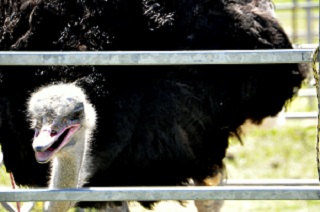 are feed-efficient, so let’s hear it for saving the environment!
are feed-efficient, so let’s hear it for saving the environment!
While we still have more cattle than ostrich in Arizona, we do have an annual Ostrich Festival every March taking place at Tumbleweed Park in Chandler, Arizona. The big event is the Great Ostrich Race.
First the crowd gets revved up
 by watching the pig races, however.
by watching the pig races, however.

This is Green Eggs and Ham racing Yellow Submarine, Red Roaster and Blue Plate Special.

After you have gotten so excited and so revved up from watching the pig races, you now can watch two different kinds of big bird races.
For the first kind, your riders are on saddles. This competitor is Jennifer, a librarian from Tucson, and this race was neck and neck!
The second race is a Ben Hur event!

In this race the riders dress like gladiators and their rides are pulling chariots! Amazing!

So far there are still more cowboys than ostrich-boys in Arizona, and more people still go to rodeo than to the Ostrich Races, but give ‘er time, as the ostrich-boys say. One of these days Arizona will be the home of ostriches everywhere! Go Big O, we love you!
For more information on the Ostrich Festival, see
To visit a working Big O ranch, try the website of the Rooster Cogburn Ranch

Tags: Uncategorized
Yaqui Worlds
by Jane St. Clair
Many centuries ago the elders of the Yaqui tribe came across Talking Tree. Now this was no ordinary tree. He was very tall and without branches or leaves so he looked more like a modern telephone pole. Two young Yaqui twins understood what Talking Tree was saying — even though the wise men of the tribe could not. Talking Tree told the little girls about the coming of Christianity and many other things that have since come to pass. The Yaqui held a beautiful ceremonial deer dance, and miraculously, a real deer came.
— After the Talking Tree prophecy, some Yaqui chose to leave the earth and live in enchanted worlds under the mountains and in the oceans. These are the Surem. Other Yaqui stayed to live on the earth.
After the Talking Tree prophecy, some Yaqui chose to leave the earth and live in enchanted worlds under the mountains and in the oceans. These are the Surem. Other Yaqui stayed to live on the earth.
The Yaqui connect to their five enchanted worlds and to the Surem  through prayer and ceremony, especially through Deer Dancer.
through prayer and ceremony, especially through Deer Dancer.
The Wilderness World or Huya Ania is where every plant, animal and rock are one and communicate. The Yaqui approach the Huya Ania in a spiritual way. They don’t just hike into the desert but they first ask permission to enter and to bless their way. It’s a very practical thing to do. It’s good to have the blessing and permission of rattlesnakes, gila monsters and puma when you invade their territory.
The Yo Ania is another enchanted world associated with caves that are a source of power to the Surem.
The Tuka Ania is the Night World filled with unusual occurrences.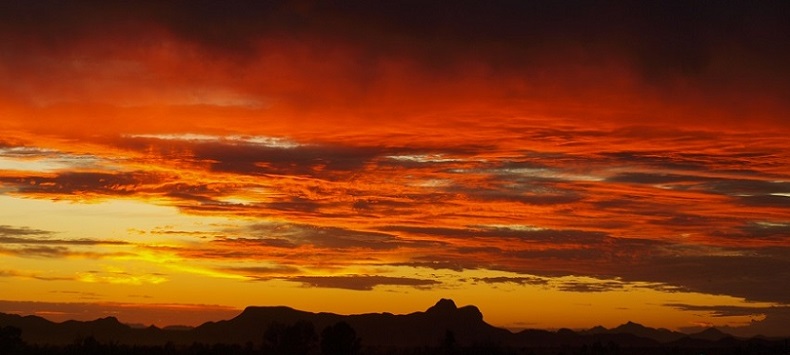
The Dream World or Tenku Ania is a private world that involves the dreams of each individual Yaqui.
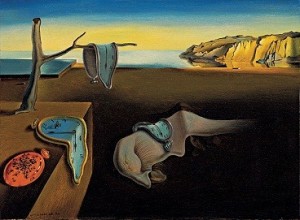
Finally, there is the Sea Ania or Flower World, the world beneath the dawn, home of Little Brother Deer or Saila Maaso. Little Brother Deer brings the blessings of the Flower World when he visits as he once did in person after Talking Tree spoke.

The flowers in Sea Ania are metaphors for all that is good and beautiful for each individual.




Deer Dancer is so very beautiful with flowers on his antlers. He has a rattle and a belt with deer hooves and he makes beautiful sounds as he dances. On his legs Deer Dancer wears cocoons that were once home to beautiful butterflies still with him in spirit.The Yaqui drummer imitates the heartbeat of Saila Maaso and musical sticks imitate his breathing.



Deer Dancer like everything about Yaqui beliefs is beautiful.
May we walk in the desert on enchanted feet like little Brother Deer. May we feel enchanted worlds in our hearts.

“One sees clearly only with the heart… Anything essential is invisible to the eyes.” …Antoine de Saint Exupery
 The above an encore presentation of a blog first published in 2014. Jane will appear on TS Radio talking about her short story “Mute” on September 2, 2020.
The above an encore presentation of a blog first published in 2014. Jane will appear on TS Radio talking about her short story “Mute” on September 2, 2020.
Tags: Arizona · Arizona photography · AZ · Jane St. Clair · Oro Valley · Tucson Sonoran Desert · Tucson Tourism
by Jane St. Clair
A donkey was smiling at me where he lives at the historic Slaughter Ranch near in Douglas, Arizona.
No, he doesn’t have anything to do with Henry David Thoreau or the Hotel Gadsden. I just liked him.

Tags: Arizona · Arizona photography · AZ
by Jane St. Clair
The Hotel Gadsden could only happen out West.
It’s so cowboy that you half-expect to see the Sheriff and his dance hall girlfriend in the downstairs saloon. The lobby is stunning.

If the big dramatic staircase looks familiar to you, it’s because you’ve seen it before at the movies. The Hotel Gadsden has been a movie set many times, and every cowboy from John Wayne to Johnny Depp has slept here.
Look closely at the staircase to find a chip in Step #7 – made by none other than the outlaw and liberator Pancho Villa. In 1916 Villa and his horse stormed into the town of Douglas and then he rode his animal up these stairs, making the chip you can still see today.
Yes, these are real Tiffany windows, 
and yes, the gold trim in the columns is genuine 14karat gold. They spared no expense when they built the Hotel Gadsden back in 1907 –it was built as the new in-spot for the A-list of the Titanic era. The interior of the Hotel Gadsden is so pretty that it can look like a Mondrian painting:
They spared no expense when they built the Hotel Gadsden back in 1907 –it was built as the new in-spot for the A-list of the Titanic era. The interior of the Hotel Gadsden is so pretty that it can look like a Mondrian painting:
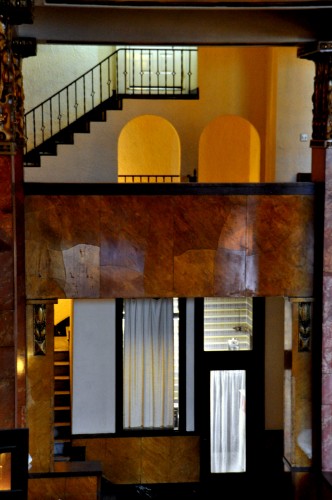
The town of Douglas is two cities in one – Douglas is in the USA and the other side, Agua Prieta is in Mexico. The two just flow together in one Spanlish culture. As we say in Arizona, coyotes don’t know about borders and birds don’t carry green cards.

The Hotel Gadsden is past its glory days when the town was full of prosperous mines and ranches. In May 2013 the TV show “Hotel Impossible” featured the Hotel Gadsden, which had been losing $200,000 a year. Hotel Impossible recommended to go modern — like, let’s get a computer for the front desk. The Hotel Gadsden is still being fixed up today, so you’ll see rolls of carpets, new furniture and fixtures in the halls.

If you’re the adventurous type, you can stay in the Hotel Gadsden and experience the authentic American West. You have to put up with little lovable glitches that all old buildings have – the elevator doesn’t always work, the phone booths have no phones, and some of the fixtures may be old. But the price of a room is really cheap ($49), and the architecture is full of little beautiful touches. If you stay at the Hotel Gadsden, the kid in you will get to cowboy up and thrill to the days of yesteryear.
and some of the fixtures may be old. But the price of a room is really cheap ($49), and the architecture is full of little beautiful touches. If you stay at the Hotel Gadsden, the kid in you will get to cowboy up and thrill to the days of yesteryear.
Hi ho, Silver, and away.
(Website of the Hotel Gadsden is “The Gadsden Hotel”)
Tags: Arizona · Arizona photography · AZ · Tucson · Tucson Tourism
by Jane St. Clair
What I love about Thoreau is that he made every moment of his short life count for something. Mostly what he did was perambulate –a wonderful word that means to walk and think at the same time. And when you’re Henry David Thoreau, perambulating counts for something.
When he was 28 years old, he left the civilized world to live full-time in the woods at Walden Pond (actually, he wasn’t far from civilization –he could walk into town whenever he wanted). 
I went to the woods because I wished to live deliberately, to front only the essential facts of life, and see if I could not learn what it had to teach, and not, when I came to die, discover that I had not lived.
I really love his word “deliberately.” Thoreau absorbed everything he saw in a deliberate way… whether it was the beauty of a large landscape (sadly, he never came out West to see the really big landscapes) 
Or a small detail of nature like the bark of a tree… 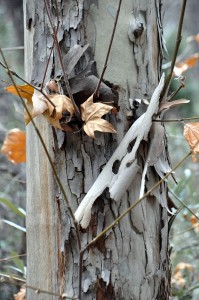
Thoreau wouldn’t have fit in 2014 with its multitasking and electronic connections for he preferred to do one thing at a time. He would have marveled at TV, video games and roller coasters because he didn’t require much stimulation to get turned on.
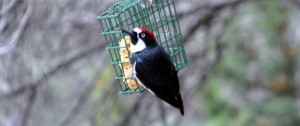
I once had a sparrow alight upon my shoulder for a moment, while I was hoeing in a village garden, and I felt that I was more distinguished by that circumstance that I should have been by any epaulet I could have worn.
Thoreau philosophized about whatever he saw in nature. He’d see a lake and a fish, for example, and come up with a line like: 
Many go fishing without knowing it is fish they are after.
Sometimes he’d get so high in nature that he’d reach mystical states, so that he understood, like all awakened souls, that: “Our truest life is when we are in dreams awake…In dreams we never deceive ourselves, nor are deceived.”
Thoreau was the first to simplify his life. He would see the point of having shelter, but not of owning a house. He would see the point of covering yourself against the wind and rain, but not of wearing fancy clothes.  I say beware of all enterprises that require new clothes, and not rather a new wearer of clothes. …. Our houses are such unwieldy property that we are often imprisoned rather than housed in them.
I say beware of all enterprises that require new clothes, and not rather a new wearer of clothes. …. Our houses are such unwieldy property that we are often imprisoned rather than housed in them.
When Thoreau was twenty-nine, he got arrested for not paying taxes because he thought the money went to an unjust war. Ralph Waldo Emerson visited him in jail and asked him something like “What’s a nice guy like you doing in prison?” Thoreau famously replied, “Why aren’t you here too?” His most influential writing is “On Civil Disobedience” which remains the classic guide to standing up to authority. It’s a great piece, but it’s not my favorite Thoreau.
My favorite is “The Battle of the Ants.” I can picture him laying on his stomach, just watching the little fellows for days on end, and then writing
an essay that compares ant wars to Aeneas. How cool is that?
You could point out that Thoreau was a rich boy whose dad owned a pencil factory, who went to Harvard, and who had wealthy influential friends –and that all those things gave him the courage to escape to the woods. You could call him a non-conformist or kook, but he knew that about himself.
If a man does not keep pace with his companions, perhaps it is because he hears a different drummer. Let him step to the music which he hears, however measured or far away.
I think he knew he was a rich kook but luckily, he didn’t care.

In every moment of his life Henry David Thoreau lived from his heart. He achieved what psychologists call self-actualization and what philosophers call authenticity. He and St. Francis would have understood one another. Both spent their lives in nature and both lived lives of deliberate authenticity. To perambulate –to walk and to think— it sounds so simple for the new year of 2014, and yet erhaps that’s what it’s all about.
Tags: Arizona · AZ · Henry David Thoreau · Jane St. Clair · Oro Valley · Tucson
by Jane St. Clair
In my next life I want to be a tree.

Buddha sat under a bodhi tree in order to achieve enlightenment. He sat under that tree for a week, but maybe the tree was already enlightened. Trees do look as if they pray all day, don’t they?
If I get to be a tree, I’d wear flowers in my hair during springtime. Maybe pink ones ..

or yellow flowers like the palo verde trees in Arizona, but either way I’d be magnificent.
In summer I’d be right there in the lushness and sensuality of the season, full of leaves with my arms spreading out in joy —
even as my cup runneth over with harvest.
In the fall, I’d be indecisive about losing my leaves and I’d be half-green and half-gold for a while …
…until I’d find myself wild in colors!
…Red! Yellow! Orange!
…Until my whole mountainside looks like a big bowl of Trix!

Yet in winter I’d have a certain beauty too — with black and white spidery webby sparkles of frost on my branches lending a certain mystic quality to my aspect.

Without greenery you see my beautiful patterns more easily ..
And you see my strange umbrella shapes when you simply look up ..
And when you look down, you see the strong vertical shapes that look like elephant legs…
If I lived in a forest with other trees, I would be dark and mysterious sometimes, sometimes leading you humans into my pathways.

So in my next life I want to be a tree. A tree that is just there –a tree that is happy all day long – not wanting or striving or doing, just being, and yet constantly changing, alive and wonderful.
The poet Wallace Stevens wrote, “Let be be the finale of seem.” He was writing about ice cream, but he might just as well have been writing about trees.

Thank you, Trees, for your contributions to the holiday season! Merry Christmas!

Tags: Arizona · Arizona photography · AZ · Jane St. Clair · nature essay · Oro Valley · Tucson Sonoran Desert · Tucson Tourist Events
by Jane St. Clair
Growing up in Chicago, I saw only flat land and I never saw any hills, much less mountains. My idea of nature was a cemetery, more so than the city parks that were noisy and full of people.

At first when I came to Arizona, I didn’t like the mountains. They blocked your view of things and looked like big boring rocks, and I never was into rocks. They were obstacles that closed you in — after all, you have to climb over them or walk around them to get where you want to go.

I didn’t know anything about mountains then — I didn’t know they have individual spirits, and that, as the Chinese say, some are charming enough to attract dragons. I also didn’t know mountains are always dancing with the clouds and the sky — complicated dances more tango than waltz, more grande ballet than two-step.

I never even knew the simple thing that clouds cast shadows on mountains. Now that is obvious to anyone but a romantic like me who assumes that clouds are light weightless things that wander lonely. No, clouds cast shadows on mountains,  and clouds can even give them stripes and diagonals that look like Navajo rugs. One cloud can snuggle into the crevices of a mountain…
and clouds can even give them stripes and diagonals that look like Navajo rugs. One cloud can snuggle into the crevices of a mountain…  Or a bunch of clouds can get together an obscure an entire mountain range …
Or a bunch of clouds can get together an obscure an entire mountain range …

And sometimes the sun lights up every crevice of your mountain, and when that happens, you can see the intricacies of your mountain better. Certain lights can change a purple mountain into a bright red one…

…And snow can even make mountains disappear ….

And then there is sunset! A good sunset can trump an entire mountain range and the whole sky itself.

I love to watch a storm come up over a mountain. Some of these great storm-rain dances can take all day! Thunderheads carrying heavy bags of rain as ominous as a nuclear mushroom overcome parts of a sky — even as its other parts can remain relaxed and sunlit.

So now I think mountains are magic and I think they are shape-changers and wonderful.
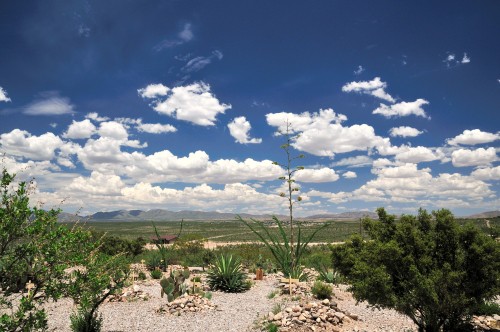
I watch mountains when there is nothing better to do,
because I’ve learned there is nothing better to do than watch mountains.

Tags: Arizona · Arizona photography · nature essay · Tucson
Sunflowers
by Jane St. Clair
Someday I will have a field of sunflowers.

I’d let people in there, but only those who love sunflowers. They’d definitely have to be sunflower people.
Maybe we’d draw their big happy faces pointed to the sun — big happy faces of ridiculous sunflowers on their gigantic stalks with their humongous roly-poly heads, awkward like people from some other planet, toddling and teetering like babies with heads too big for their bodies —
 — but sunflower people like us understand them.
— but sunflower people like us understand them.
We’d watch our field of sunflowers, we’d watch the way the wind bends them down and the way they move in unison sometimes, sometimes not. The way their bright yellow is perfect against a turquoise sky!
The way they appear to be smiling just at you!

Hello Sunflower! Taller than me! 
We won’t think about water or soil or seeds or any such thing. We would just have sunflowers.
We would never put them in a vase because they are too big and they belong in a sunflower field after all. They are too big and electric with light and sun to go into a vase. Can you really think that you could vase-up magic? Van Gogh knew better, which is why he got crazy-high drawing a simple vase full of simple sunflowers. He knew the power of sunflowers, yes indeed he did.

If you walk through a field of sunflowers, you can get drunk and slant without drinking anything at all!

The sight of them –with their wild colors and crazy shape and the way they sway and dance in the sun– makes you, as Emily Dickinson wrote, “reel through an endless summer day.” And you just reel away — tipsy slant! High on nature– you taste her liquor never brewed, you debauchee of sunflowers, you!

For more of Jane’s writing about Emily Dickinson, go here.
Tags: Arizona · Arizona photography · Jane St. Clair · nature essay
by Jane St. Clair
Superior, Arizona looks like a movie set from the 1950s. It’s perfect for a science fiction movie in which something terrible has happened! An atomic bomb just went off! Or Godzilla just thumped through town.
 Hey, lizard, lizard, lizard.
Hey, lizard, lizard, lizard.
There’s a town here and all the people have vanished! Nobody’s home!
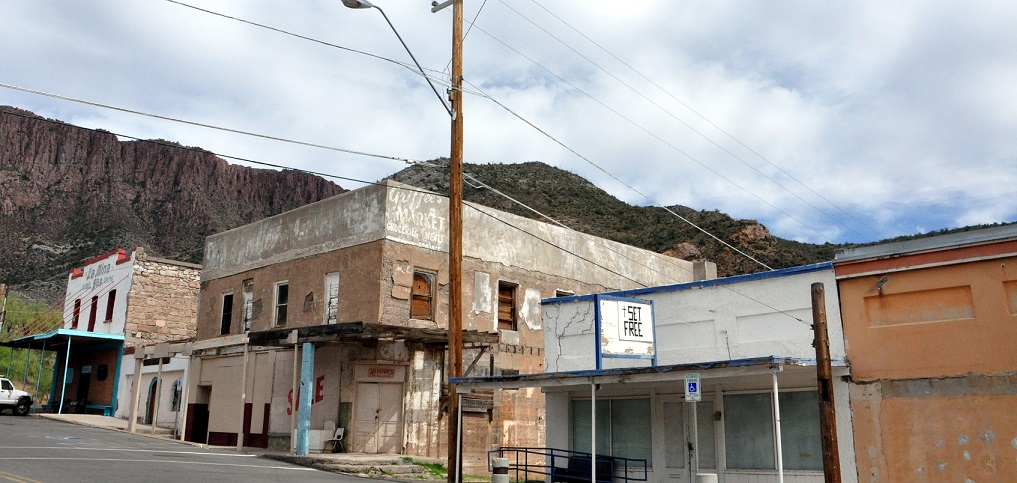
Nothing ever dies on the desert, not even towns like Superior, Arizona, which is only a half-ghost town. Although parts of Superior are still going, most is boarded up and empty.
Although parts of Superior are still going, most is boarded up and empty.

Superior Arizona dates back 120 years to the opening of the Magna Copper Mine. It closed in 1994 but you can still see it if you stand on a certain hill.
It closed in 1994 but you can still see it if you stand on a certain hill.
Today the old Magna Copper Hotel is boarded up and propped up by big concrete blocks, like an old man with two walking sticks.
Shop after shop is for sale. Some have a 50s vibe.
Some are from an earlier time..
.
Some are later.

But they’re all on the same chopping block.
The town got some governmental money for renewal and you can see the spots where it helped. The young people in town painted a mural that shows they love the place.
It is nice to think Superior will come back someday, but meanwhile, it’s like desert plants that can look dead for months and yet they are really alive. What Superior needs is some sugar-daddy movie star to buy it, the way Kim Bassinger once bought an entire town in Georgia. It’s such a nice town! Everybody’s so sweet there! Don’t let it fade away!
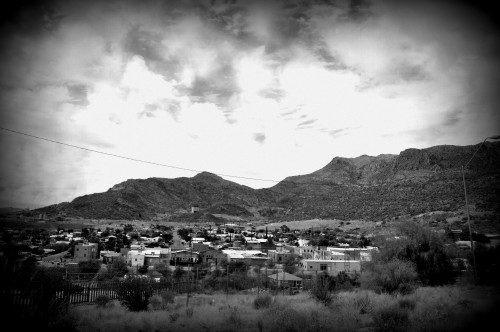
Hey, movie star, movie star, movie star.
Tags: Arizona · Arizona photography · AZ · Jane St. Clair · Superior · Tucson
by Jane St. Clair
Our Lady of Guadalupe is everywhere in the Southwest. I have even seen her image over a bar next to a velvet Elvis painting.

She is of course in chapels

but people also name schools and businesses after her.

I have seen Our Lady of Guadalupe earrings, bumper stickers, baseball caps, throw blankets and tote bags 
mouse pads, spaghetti strap tee shirts, ipad cases, cups,  garden statues,
garden statues,
Christmas windows,

murals, clocks, coasters, magnets,
iron-on transfers, 
calendars, and
coloring books.

Those who say it is wrong to do that — don’t understand it. We keep images of Our Lady of Guadalupe near us all the time the way you hang up pictures of people  you love around your house.
you love around your house.
Our Lady of Guadalupe first appeared to St. Juan Diego in Mexico in 1531. When he opened his tilma, roses spilled out of it even though it was winter! Her beautiful image remains on the tilma today. Scientists have analyzed the tilma with carbon dating and such, but it’s not a scientific thing. People believe God the Father made the image the way God is doing in this painting:

Our Lady of Guadalupe has the titles of Queen of Mexico and Empress of the Americas and yet she is so very young – maybe just 15 years old. Instead of a halo, she has aura of light surrounding her whole body .. an aura like the golden aura of rays around a happy Southwest sun.

She did not come as an Anglo mother –the way the Europeans paint her, but as a beautiful Aztec princess who speaks the Aztec language.
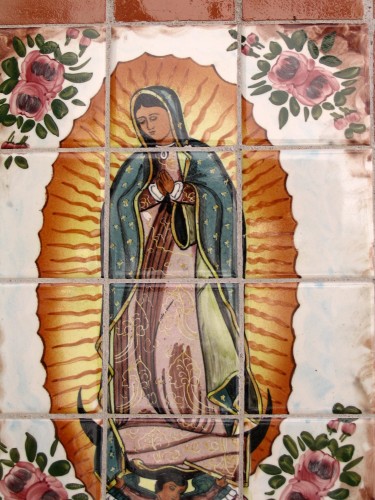
If she were music, I don’t think her song would be Ave Maria. It would be happier lighter music full of light because she is the one who brings the hope of the world. Nuestra Señora de Guadalupe, Gracias! Te amamos!

Tags: Jane St. Clair · Our Lady of Guadalupe · Tucson
 Everyone in Arizona thought the hombre was nuts but nevertheless, the stranger went about convincing people that ostriches were better than cattle and horses.
Everyone in Arizona thought the hombre was nuts but nevertheless, the stranger went about convincing people that ostriches were better than cattle and horses. This bird stands eight to nine feet tall and weighs about 350 pounds. They run much faster and they can pull chariots!
This bird stands eight to nine feet tall and weighs about 350 pounds. They run much faster and they can pull chariots! but they are still the world’s largest bird.
but they are still the world’s largest bird. are feed-efficient, so let’s hear it for saving the environment!
are feed-efficient, so let’s hear it for saving the environment! by watching the pig races, however.
by watching the pig races, however.























 The above an encore presentation of a blog first published in 2014. Jane will appear on TS Radio talking about her short story
The above an encore presentation of a blog first published in 2014. Jane will appear on TS Radio talking about her short story 





































































